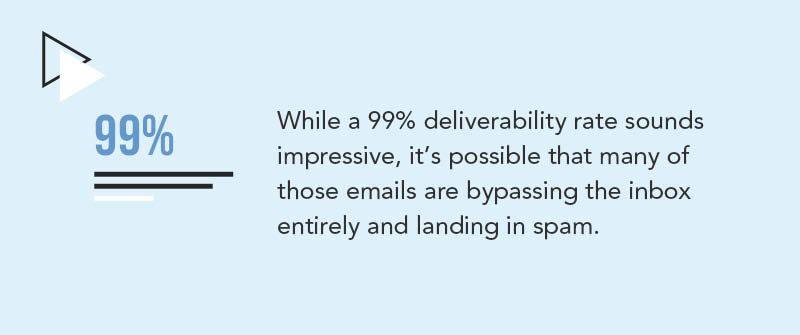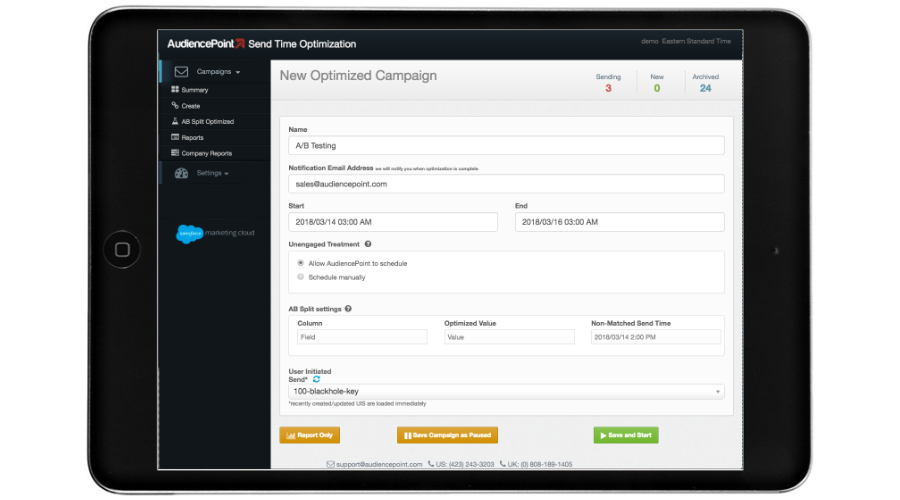AudiencePoint is thrilled to announce our new integration with Klaviyo! AudiencePoint is looking for partners to pilot our...
What Does Email Deliverability Mean In 2025?
Email deliverability in 2025 is more critical—and more nuanced—than ever before. At its core, email deliverability refers to the likelihood that your emails will make it past filters and technical checkpoints to successfully reach your subscribers’ inboxes, not just being accepted by mail servers. In an era where inbox competition is fierce, high deliverability (typically recognized as 95% or greater) now directly translates to a major advantage in campaign effectiveness and revenue growth. Knowing how to use AI in email marketing can further enhance deliverability by optimizing send times, personalizing content, and predicting engagement patterns that improve inbox placement rates.
Email Deliverability Comparison: Which ESP Has the Best Deliverability?
Simply put, email deliverability is the measure of how many emails sent by your brand actually arrive in your intended recipients’ inboxes. This is distinct from delivery rate, which only tracks whether a server accepted your message. Deliverability gets to the heart of whether your message truly reaches a user—or gets diverted to the spam folder or the promotions tab (especially in Gmail), both of which can impact the visibility of marketing emails, or even lost altogether. Contemporary email deliverability statistics show that brands leading the way maintain rates above 97%, while those falling short can see their messages largely ignored, severely impacting ROI.
How Is Deliverability Different From Inbox Placement?
The distinction between deliverability and inbox placement has become one of the most important discussions for enterprise email marketers. Deliverability gauges if your message is handed off to the receiving server, while inbox placement answers the million-dollar question: did the email land in the main inbox—the most valuable placement for marketing emails—or somewhere less visible, like spam or promotional tabs? Inbox placement rates provide deeper operational intelligence, exposing hidden issues in sender reputation and engagement that are invisible if you’re only monitoring basic delivery rates. Today, investing in accurate inbox placement analytics often makes the difference between incremental gains and outsized campaign success.
Key Differences Between Deliverability And Inbox Placement
Understanding the difference between deliverability and inbox placement is critical for any serious marketer. While a 99% deliverability rate sounds impressive, it’s possible that many of those emails are bypassing the inbox entirely and landing in spam. Inbox placement monitoring exposes whether your campaigns are resonating and being received where they matter most. Tools like AudiencePoint now empower marketing teams to move beyond basic deliverability, providing advanced deliverability features such as inbox placement testing and comprehensive analytics on exactly how and where messages are delivered, and which segments are at risk of disengagement or filtering. This allows for precision targeting, prompt corrective actions, and more robust engagement strategies.

Industry Statistics: Where Do Marketers Stand In 2025?
According to recent email deliverability statistics, industry leaders keep consistent rates above 97%, but even top-performing organizations risk falling short if inbox placement isn’t monitored rigorously. The average deliverability rate is a key metric for evaluating email campaign performance, with a deliverability rate between 95-100% considered best-in-class; if sampling uncovers rates below 90%, your sender reputation, authentication, and subscriber engagement must be reassessed. In 2025, the strongest enterprises leverage AudiencePoint’s advanced analytics to benchmark their performance and proactively defend their inbox share.
Why 95%+ Deliverability Is Non-Negotiable
For enterprise marketers, a deliverability rate of 95% or higher isn’t just a target—it’s fundamental for maintaining visibility, maximizing engagement, and protecting sender reputation. Rates below this threshold show the warning signs of list decay, poor segmentation, or technical shortcomings that will erode your brand’s credibility over time. In a data-driven environment, every basis point of improvement equates to significant increases in campaign revenue and customer lifetime value. AudiencePoint brings this into focus with real-time monitoring and predictive insights that help marketers enhance deliverability and maintain best-in-class performance at scale.
The Importance Of ISPs And Sender Reputation In 2025
Internet service providers (ISPs) have grown vastly more sophisticated in how they assess and filter incoming email. Your sender reputation acts as your passport—dictating whether you’re a trusted sender who lands in the inbox, or flagged as a potential spammer consigned to the junk folder. ISPs weigh engagement rates, spam complaints, authentication protocols, and subscriber behaviors to make these judgments. In 2025, the only way to remain one step ahead is through vigilant list hygiene, authenticated sending practices, and leveraging specialized platforms like AudiencePoint, which provide the data intelligence needed to optimize for both deliverability and true inbox placement. Proper sender configuration is also crucial, as it ensures your technical setup supports high inbox placement and helps you avoid spam filters. Ignore these essentials, and even your best-crafted campaigns will lose their competitive edge.
How Is Email Deliverability Measured And Tested?
Email deliverability is a critical metric for enterprise email marketers, but understanding how to accurately test and measure it requires a sophisticated approach. Traditionally, deliverability has been measured using seedlist data and panel data, but both approaches come with notable limitations. Today, advanced email deliverability tools and innovative technologies—such as those from AudiencePoint—provide deeper, actionable insights, especially when it comes to true inbox placement monitoring.
How Do You Test And Measure Email Deliverability?
To truly understand your email deliverability rate, marketers have historically leveraged seedlist methodology. This involves sending test emails to dedicated seed email addresses monitored across various ISPs and providers. While this method offers a baseline by revealing if emails land in inboxes or spam folders, it only represents a tiny fraction of your list and can miss critical nuances in deliverability affecting your core audience. Similarly, panel data—collected from active users who opt in to track their email experience—helps identify patterns in open and click behavior, but is typically skewed due to user bias and device limitations.
More sophisticated approaches now combine these traditional metrics with comprehensive behavioral data and deliverability signals—such as bounce rates, spam complaints, and engagement rates—to deliver a holistic view. Automated email deliverability tests through platforms like GlockApps or Litmus can check for technical issues, spam trigger words, and authentication (SPF, DKIM, DMARC). Additionally, using a spam checker helps identify and reduce spam scores, preventing your emails from landing in spam folders and improving overall campaign performance by providing actionable recommendations before you send to an entire list.
What Are The Most Effective Ways To Monitor Inbox Placement?
Until recently, marketers struggled to see past generic deliverability metrics. The real breakthrough lies in modern inbox placement monitoring. Instead of relying solely on seeds or panels, advanced solutions like AudiencePoint now continuously ingest all major inbox signals from your actual subscribers—send, opens, clicks, bounces, unsubscribes—and compare these with an extensive pool of real-world data, while also monitoring deliverability across various mailbox providers to ensure consistent inbox placement. This shift uncovers not just if your emails are delivered, but if they actually land in the inbox or are filtered to spam, and on which providers.

AudiencePoint is a leader in this space, empowering enterprises to precisely identify pain points affecting inbox rates. By spotlighting which specific segments or campaigns suffer from poor placement, marketers can make data-driven adjustments—like list hygiene, sending behavior, or content tweaks—to maximize the true reach of every message. Furthermore, AudiencePoint’s actionable insights take the guesswork out of measurement and help you reduce spam rates, manage bounces, and optimize for every major spam filter on the market.
Interpreting Spam Rates, Bounce Rates, And Placement Metrics
Mastering deliverability isn’t just about tracking a delivery confirmation; interpreting spam rates, bounce rates, and inbox placement metrics is crucial for continuous improvement. For example, a high delivery rate is meaningless if inbox placement is low—campaigns could surface almost exclusively in spam folders. By closely monitoring these metrics (and identifying root causes for negative trends), enterprise marketers can prioritize high-impact optimizations, protect their sender reputation, and consistently outperform industry averages.
To stay ahead in 2025, enterprise marketers need to move beyond legacy methodologies and embrace robust, real-time deliverability and inbox placement tools like AudiencePoint. Using a comprehensive deliverability report from these tools can help identify specific issues affecting inbox placement, such as spam triggers or authentication problems, and provide actionable insights to guide optimizations. This is the new standard for ensuring your brand’s emails reach, engage, and convert the audiences that matter.
Which Email Service Has The Best Deliverability?
For enterprise email marketers and marketing executives, the question of which email service provider (ESP) delivers the best performance in 2025 is paramount. The answer is multifaceted: while several major email service providers—such as Mailgun, SendGrid, Amazon SES, and Mailchimp—consistently rank highly, the best deliverability ultimately depends on the synergy between the platform’s capabilities, its deliverability infrastructure, and your internal email practices. No single email service provider offers a universal guarantee, but there are clear leaders in deliverability—and strategies to maximize your results regardless of which service you use.
Top-Rated ESPs For Deliverability In 2025: Comparative Analysis
In third-party deliverability rankings, platforms like SendGrid and Mailgun remain trusted workhorses for transactional and bulk email campaigns, posting competitive inbox placement and deliverability statistics. Amazon SES offers enterprise-grade infrastructure and market-leading scalability, though it demands a technically adept team for optimal configuration. Mailchimp shines for marketers seeking a user-friendly interface, native list hygiene features, and robust data insights; recent improvements in authentication and automation bolster its inbox placement rates. Providers like SparkPost, Postmark, and ActiveCampaign also deserve recognition for innovations in sender reputation management and anti-spam mechanisms. Integrating a deliverability tool with these ESPs can further enhance performance by monitoring inbox placement, checking authentication, and analyzing sender reputation to ensure emails consistently reach subscribers’ inboxes.
Transactional Vs Marketing Email Services: Deliverability Pros And Cons
Not all ESPs serve the same purpose with equal proficiency. Transactional email services (e.g., Mailgun, SendGrid, Postmark) are engineered for high-velocity delivery and real-time notifications, with infrastructure optimized for critical, time-sensitive messages. Their deliverability metrics are typically high due to streamlined sending processes and rigorous authentication. Marketing ESPs (e.g., Mailchimp, ActiveCampaign) focus on list management, campaign tracking, and engagement optimization. While both can achieve excellent deliverability, transactional email services see slightly higher average rates due to real-time engagement and reduced risk of bulk-sending related filtering.

Deliverability Benchmarks: How Do The Leaders Stack Up?
Recent third-party benchmarks show Mailgun and SendGrid with deliverability rates consistently above 95%, while Amazon SES matches or exceeds those numbers when configured correctly. Mailchimp’s average inbox placement—especially for senders who follow best practices—rivals the transactional platforms. However, raw deliverability rate only tells part of the story; inbox placement, sender reputation, and ongoing authentication compliance all contribute to the effective reach of your campaigns. Email configuration analysis plays a crucial role by identifying misconfigurations and authentication issues, helping to improve inbox placement and overall email setup health. Top ESPs distinguish themselves by providing advanced tools and proactive customer support to ensure high deliverability regardless of shifting ISP algorithms.
Real-World Case Studies And Ranking Insights
Comparative studies—such as those by EmailToolTester, Validity, and third-party agencies—affirm that leading ESPs are closely clustered near the top of deliverability charts. The difference between “good” and “great” often comes down to diligent list maintenance, engagement-driven content, and leveraging the latest authentication protocols. Enterprises using AudiencePoint with any of these top ESPs can optimize performance further, gaining real-time monitoring of inbox placement and subscriber engagement across millions of data points—something no traditional ESP or seedlist tool can match. Regular email deliverability testing is also essential for ongoing improvement, helping to identify and resolve issues like spam filter triggers, IP reputation, and domain authentication. This unification of platform strength, actionable insight, and consistent email deliverability testing is the real differentiator in inbox placement success.
What Factors Set High-Performing ESPs Apart?
Ultimately, high-performing email platforms invest in infrastructure quality, relentless spam and phishing protection, and transparent, data-driven reporting. They also offer robust support for SPF, DKIM, and DMARC authentication, dynamic engagement optimization, and easy integration with insight platforms like AudiencePoint. Proper sending configuration is essential to maximize inbox placement and avoid deliverability issues, as it directly impacts how emails are filtered and received. Marketers should view their choice of ESP as the foundation, while continuous deliverability monitoring and inbox placement analytics are the structure that will differentiate their campaigns and maximize ROI in 2025 and beyond.
Which Email Service Has The Least Spam And Best Inbox Placement?
For enterprise email marketers, minimizing the proportion of emails that land in the spam folder is mission-critical to maintaining high engagement, driving conversions, and safeguarding sender reputation. The email service provider (ESP) that has the least spam placement is one that not only delivers messages reliably but also incorporates advanced inbox placement strategies, spam filtering technologies, and fosters excellent engagement metrics through best-in-class list hygiene practices. The best platforms are those that give brands granular control and visibility into not just delivery, but actual email placement—empowering teams to monitor, test, and optimize where emails land, ensuring more messages reach the inbox rather than spam for better outcomes.
Spam Filtering: How Leading Platforms Minimize Spam Placement
Top-tier ESPs deploy sophisticated spam filtering and authentication protocols such as SPF, DKIM, and DMARC to maximize inbox placement rates and reduce the risk of messages being flagged as spam. However, spam filtering is only part of the equation. Today’s successful ESPs leverage reputation management systems, AI-driven engagement monitoring, feedback loops from major ISPs, and incorporate spam tests to proactively identify and address potential spam issues before they escalate. This multi-layered approach ensures that every effort is made to keep your campaigns in the primary inbox and out of spam folders.
Role Of Engagement And List Management
Engagement metrics—the rate at which recipients open, click, or reply—are powerful signals inbox providers use to determine future inbox placement. Low engagement, high complaint rates, and poorly managed lists (such as sending to inactive or spam trap addresses) often trigger increased spam placement. That’s why the leading ESPs incorporate automated list hygiene processes, enable easy identification and removal of dormant subscribers, and offer dynamic segmentation tools. Maintaining list hygiene also involves regularly identifying and removing inactive or invalid addresses to improve deliverability and avoid spam traps. AudiencePoint, for instance, analyzes your historical engagement across a massive network, advising specifically which subscribers are driving placement issues, and helping you take targeted action to restore reputation and improve deliverability.
Evaluating ESPs By Inbox Vs Spam Folder Placement Rates
Simply boasting a high deliverability rate isn’t enough—what matters is how many messages actually reach the inbox. AudiencePoint’s next-generation insights platform goes far beyond traditional seedlist methodologies, tracking true inbox placement rate on a subscriber-by-subscriber basis. Incorporating inbox placement tests provides accurate, real-world data by simulating how emails are delivered across different mailbox providers, helping marketers identify deliverability issues and optimize their campaigns. By comparing your campaigns’ inbox and spam folder performance directly against industry benchmarks and ISP data, marketers using AudiencePoint gain a clear view of which lists and tactics are working, which are causing issues, and where remediation is needed most. This data-driven approach is essential for maximizing ROI and scaling email success confidently.

Importance Of Authentication (SPF, DKIM, DMARC)
Without proper authentication, emails are more likely to be marked as spam—even if your content and list practices are strong. Proper email authentication, through the implementation of standards like SPF, DKIM, and DMARC, is essential for improving deliverability and protecting against phishing and spoofing. The best ESPs automate and require these protocols, insulating their users from many technical reputation pitfalls and ensuring major ISPs recognize your sending domains as trustworthy. AudiencePoint’s tools also monitor changes and recommend improvements in your authentication configurations as part of an all-encompassing deliverability optimization stack.
Real-World Examples Of ESPs With Top Inbox Placement Rates
While stats and case studies show that ESPs like Mailgun, Amazon SES, and SendGrid generally perform well, true leaders separate themselves through transparency, insights, and actionable recommendations. AudiencePoint’s Inbox Placement solution, trusted by large B2C brands, identifies which segments are most at risk for low placement and enables you to swiftly adapt. This is what differentiates solutions aimed at optimization from those that simply report on aggregate numbers—empowering email marketers to maximize every deployment’s reach and ensure messages land in subscribers inboxes and avoid spam folders for optimal engagement. In today’s landscape, partnering with AudiencePoint means turning inbox placement from a guessing game into a strategic advantage that delivers measurable results.
What Strategies And Tools Can Improve Email Deliverability?
Email deliverability remains a non-negotiable pillar for enterprise marketers aiming to maximize ROI and ensure campaign success. The right mix of strategies and tools, including sophisticated email deliverability tools such as MXToolbox, not only safeguards your sender reputation but also elevates every aspect of your customer journey. To supercharge your 2024 email results, combining rigorous list management, advanced engagement tactics, and modern deliverability monitoring tools like AudiencePoint is essential.
The Role Of List Segmentation And Engagement In Boosting Deliverability
Effective audience segmentation and engagement strategies are directly linked to improved deliverability. By segmenting your email list based on user behavior, demographics, or purchase history, you ensure that messages are relevant and timely, fostering higher open and click-through rates. Incorporating email validation as part of your list hygiene practices helps maintain a healthy list and improves deliverability by reducing bounces and protecting your sender reputation. High engagement signals, such as regular opens and genuine clicks, are strong indicators to ISPs that your content is valuable and wanted—helping you avoid spam folder purgatory. Leveraging real engagement data, platforms like AudiencePoint empower you to fine-tune your content strategy and optimize every send for maximum inbox placement.
Best Practices: Double Opt-in, Regular List Cleaning, And Sender Authentication
Adhering to deliverability best practices is non-negotiable. A double opt-in process captures only genuinely interested subscribers, dramatically reducing the likelihood of spam complaints or disengaged recipients poisoning your sender score. Regular list hygiene—removing inactive or unengaged users, as well as invalid addresses to reduce bounce rates and improve sender reputation—further protects your reputation. Perhaps most importantly, implementing robust email authentication protocols (SPF, DKIM, DMARC) builds trust with ISPs and ensures your emails are recognized as legitimate, reducing the risk of phishing flags and improving overall deliverability rates.
Top Deliverability And Inbox Placement Tools In 2025
Evolving beyond legacy measurement, today’s leading email deliverability tools go far deeper than simple seedlist or panel data. Solutions like AudiencePoint harness advanced data and machine learning to provide inbox placement insights across your entire subscriber base. This granular view allows you to identify which addresses are at risk of spam foldering and take rapid corrective action. Other top tools, such as GlockApps and Litmus, as well as other email deliverability tools that offer features like blacklist monitoring, DMARC analysis, and reputation tracking, provide diagnostics on placement, content scoring, and infrastructure optimization. However, only AudiencePoint delivers true scalability, third-party benchmarking, and the actionable intelligence needed for large enterprise campaigns.
Monitoring And Acting On Deliverability Metrics
Continuous monitoring of bounce rates, open and click metrics, and spam complaint trends is critical. With actionable data from tools like AudiencePoint, marketers can pinpoint delivery issues in real time and suppress at-risk contacts before sender reputation suffers. Monitoring these metrics also helps identify and resolve deliverability issues before they impact inbox placement or sender reputation. Automated alerts and dashboards streamline decision-making—allowing agile responses to provider algorithm changes or evolving audience preferences.

Why Focusing On Inbox Placement Is The Next Frontier
While traditional deliverability tells you if an email was accepted by the ISP, real business results depend on inbox placement—whether your emails land in the inbox or the spam folder. Marketers who focus efforts here benefit from higher engagement, greater revenue per send, and stronger customer relationships. With new technologies like AudiencePoint and by leveraging an email deliverability tool to measure and optimize inbox placement, achieving these goals is finally scalable and accurate enough for enterprise requirements. The result? Brand safety, improved reputation, and measurable uplift in campaign KPIs. Now is the time to stop flying blind and leverage the next-generation deliverability platform built for market leaders.
Conclusion: Choosing The Right ESP And Focusing On Inbox Placement
Choosing the right email service provider (ESP) is foundational for any enterprise email marketer aiming to maximize campaign ROI through effective email marketing. In a landscape where virtually every leading ESP promises high deliverability rates, focusing solely on basic deliverability statistics can lead to missed engagement opportunities. Instead, the true differentiator in 2025 is excellence in inbox placement—the measure of how many emails make it not just through the server, but into the recipient’s primary inbox, where real action takes place.
Which ESP Should Marketers Choose For The Best Deliverability?
While ESPs such as Mailgun, SendGrid, Amazon SES, and Mailchimp all perform admirably regarding raw deliverability rates, the decisive advantage belongs to those providers that invest in advanced data intelligence and continuous engagement measurement. The optimal ESP for your organization will offer robust analytics, precise segmentation, real-time inbox placement monitoring, and seamless integration with the best email deliverability tools for maximum performance. Ultimately, tools like AudiencePoint can integrate with any major ESP—transforming raw email data into actionable insights you can trust to improve deliverability and optimize content strategy.
Why Is Ongoing Deliverability Monitoring Essential?
ESP performance and recipient behaviors are in constant flux. Without persistent monitoring, marketers risk declining engagement, reduced IP reputations, and creeping placement into spam folders. Monitoring IP reputation is especially important, as a poor IP reputation can directly impact inbox placement and increase the likelihood of emails being filtered as spam. Modern measurement goes far beyond seedlist tests or mere delivery reports. Ongoing deliverability monitoring empowers your team to adapt to changing ISP algorithms, track which segments are experiencing reduced placement, and remediate delivery issues before they cascade into broader reputation problems. This proactive approach is no longer optional—it is mission-critical for scaling revenue and maintaining email program health in 2025.
Final Recommendations And Steps Marketers Can Take Today
To achieve industry-leading deliverability, combine a reputable ESP with the power of advanced deliverability tools. Prioritize real engagement metrics, leverage third-party inbox placement measurement, and commit to regular list hygiene and IP warming. Building a positive sender reputation is essential for long-term success—advanced tools and consistent engagement help establish and maintain this reputation with mailbox providers. Tools such as AudiencePoint stand out by providing visibility into every stage of your email funnel—Send, Delivered, Inboxed, Opened, and Clicked—so you can optimize campaigns with confidence.
The bottom line: Top brands are looking beyond traditional deliverability rates to put inbox placement and engagement at the heart of their strategy. AudiencePoint’s intelligence platform aggregates real activity data from billions of data points, allowing your team to identify deliverability obstacles and revenue opportunities before your competition. Don’t settle for guessing—invest in visibility and results. Book a customized AudiencePoint demo today and discover how leading enterprise marketers are reshaping their outcomes by prioritizing inbox placement. Outperform your peers, safeguard your sender reputation, and drive ROI with data-driven precision from AudiencePoint.





